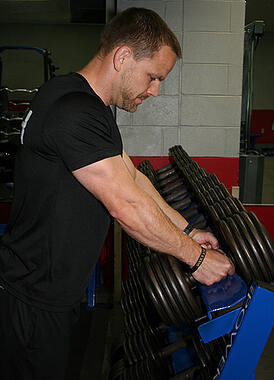Episode #2: Have a plan, ink the plan, and work the plan.
 In the first episode of “Do You Even Lift, Bro?” I concluded with the notion of absolute strength as the foundation to fitness. The stronger you are, the more things you will be capable of across the fitness continuum. World-renowned coach Dan John explains this best for me with a bucket analogy: The bigger your bucket is (your absolute strength), the more room you have to put in things like mobility, power, speed, and endurance, among other things. To get stronger, you have to lift heavy things--bottom line.
In the first episode of “Do You Even Lift, Bro?” I concluded with the notion of absolute strength as the foundation to fitness. The stronger you are, the more things you will be capable of across the fitness continuum. World-renowned coach Dan John explains this best for me with a bucket analogy: The bigger your bucket is (your absolute strength), the more room you have to put in things like mobility, power, speed, and endurance, among other things. To get stronger, you have to lift heavy things--bottom line.
So now I hope you all understand how important strength is, and the weight room is where you can really develop your strength. The key is having the proper progression in the program that will overload the system, causing adaption and ultimately strength in the major movement patterns that we live in. Now, I can talk about programming for 8 hours straight and still barely scratch the surface. My hope in this post is to give you a few super-important facets that should be a part of your weightlifting program. I’m going to work fast here, so try to keep up!
Master These Movements
Human movement can be broken down into six major movements. When planning your assault in the weight room, be sure to include these movements in your attack:
- Squat: Bending at the knees and hips as if sitting down and standing up
- Hinge: Bending at the hips to pick something up from the floor, like a Dead Lift
- Push: Pushing weight away from your body either vertically or horizontally, like a push-up
- Pull: Pulling weight toward the body, like a pull-up
- Lunge: Lifting legs in a split stance
- Rotary/Core: Spine stabilization and rotating
Pairing movements is one of the best ways to get the most out of your time in the weight room. To reduce residual fatigue, I recommend pairing movements that complement each other, such as a Squat with a Pulling movement. The Squat is an anterior (front) lower-body movement, while the Pulling exercise is a posterior (back) upper-body movement. Simply put, one can rest while the other is in motion, maximizing effort and making recovery time more efficient.
Plan in Four-Week Blocks
Again, I could spend hours discussing the different parameters of the “block system” of programming, but I’m not going to. All I want you to keep in mind when planning is to keep it to a month-long (four-week) cycle. After you have completed a workout four times, it’s time to reevaluate and progress. We can define progression as increasing the weight used in an exercise, increasing the number of reps, or adding something to the exercise that makes it more demanding. Changing all these things at once is not the best idea, but making some changes is key to providing the overload principle necessary in strength gain. You have to change it up!
Reps, Sets, and Weight Selection
I know I sound like a broken record, but there is so much that has be taken into account when discussing these three key aspects of your program. Goals, fitness level, and timeline just to name a few, are all things that need to be considered when designing your plan, and I can’t cover all these details in one small blog post. As a safe and beneficial rule of thumb, 2 to 3 sets at 6 to 8 reps of each movement will do the trick. The weight should be challenging enough to complete all reps, but not sacrifice the form of the movement. If you know your predicted 1RM (hyperlink to fitness assessment) of each movement (which you can find in a free assessment with an HFS here at NIFS), you can use percentages of that weight in your sets and reps. Use the “first and last” rule: the last rep should look like the first rep. I would also recommend starting at a lower weight for your first set, and increasing weight every subsequent set. Again, this is the overload concept that is the cornerstone of building strength.
I can’t stress enough the importance of having a plan and working that plan. Having a sound plan of attack will keep you on track, provide accountability, and show you where you were and where you are now. I urge you to seek out the advice of a qualified fitness professional when beginning or tweaking your strength-training program. I’m talking to the veteran lifter, too; you can always improve on something you are doing. Implementing the preceding strategies is a great first step.
If you are interested in setting up a personal fitness program with Tony click the button below:
Tony Maloney is the Fitness Center Manager and leads group training Sunday through Thursday.

